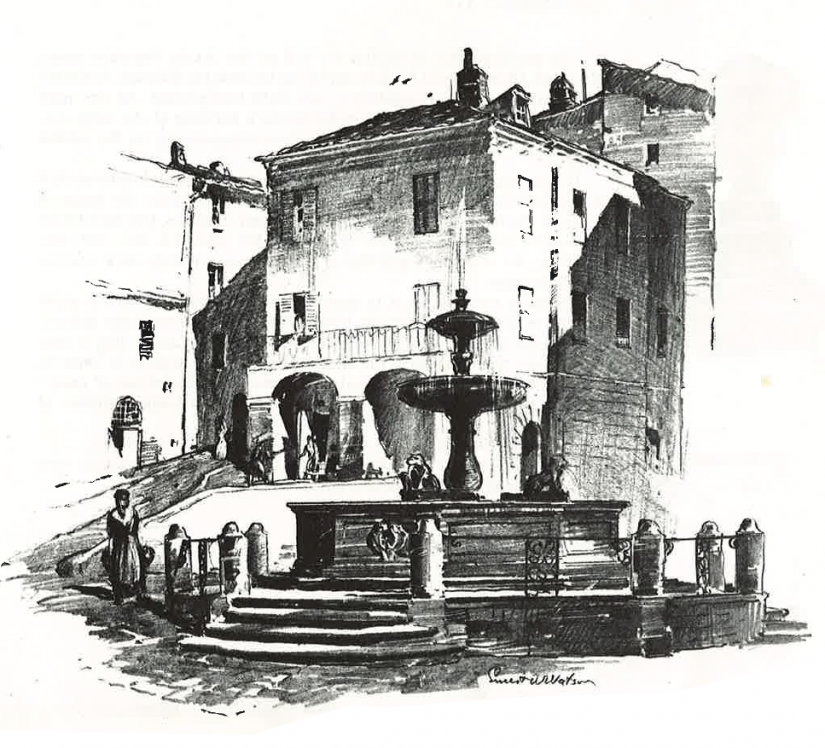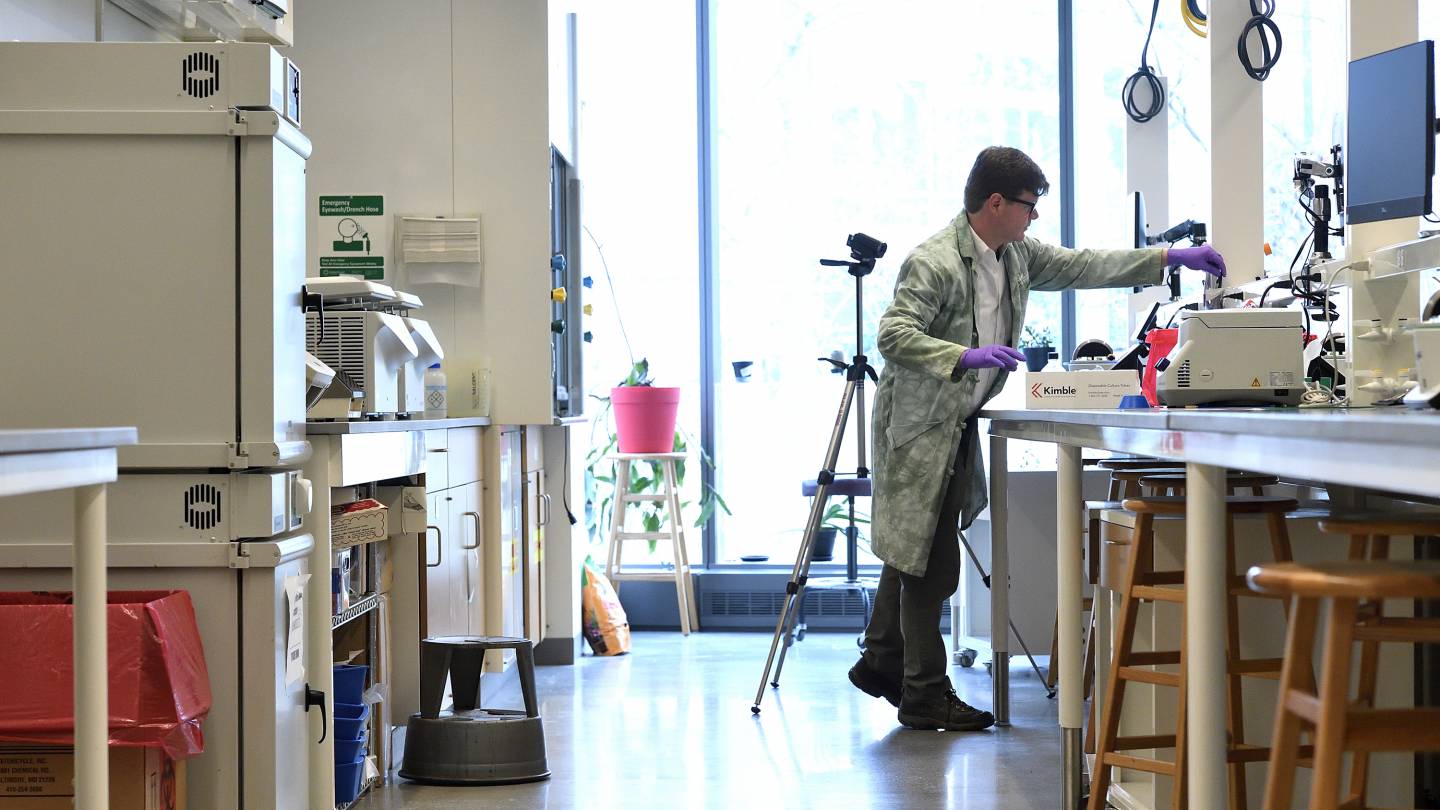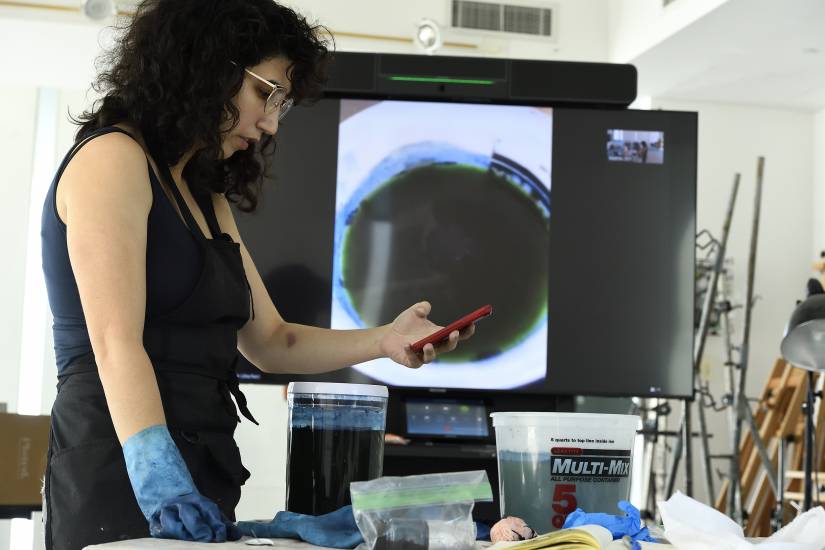One recent Friday afternoon, Luc Phinney took his Art of Architecture students on a sketch trip to Assisi, Italy. Instructors at the Johns Hopkins Krieger School of Arts and Sciences had been advised to give students a bit of breathing space while they grappled with the stresses inherent in the online semester, and Phinney figured a vacation would be just the thing. Not physically, of course. Instead, the Center for Visual Arts instructor asked his class to visit the website Google Earth, and gave them a puzzle: find the fountain in a famous sketch he showed them.
The class "walked" around the town and located the Fontana dei Tre Leoni in the Piazza del Comune. Phinney had provided a list of architectural details the week before, and now he asked the students to break into Zoom groups to explore the piazza's buildings and decide which ones to draw.
"The groups formed up organically just like they would if we were actually there in person," Phinney says. "They had their cameras on, they were talking to each other; I couldn't believe it. It turned out to be just what we all needed."
The art of science and the science of art
What does a pencil have in common with a pipette? Both require specialized skills to operate—skills usually acquired through repeated practice, and which become fundamental building blocks. If you can't use a pipette effectively, your data may suffer and cloud your results. If you haven't experimented with various angles for your pencil or drawing pad, it will be challenging to progress more deeply into content.

Image caption: Phinney challenged his students to locate on Google Earth the Fontana dei Tre Leoni using only this sketch as a reference for their search
Image credit: Courtesy of Luc Phinney
As they work through the school's first fully online semester, Krieger School science and art instructors share some frustrations and joys. For those foundational skills, they miss the opportunity to wander through a room of novice pipette- or pencil-wielding students, offering gentle corrections in real time. But they have also discovered that recorded demonstrations, complete with close-ups and voiceovers, are surprisingly effective in teaching technique, especially when contrasted with the traditional model where students crane over one another's shoulders to watch an instructor hunched over a classroom table.
Instructors also share the struggle to build the sense of community that generates the collaboration necessary to create art or practice science. Although nothing matches being together physically, they are finding that students in small teams are more likely to leave their cameras on and engage with one another than those in large Zoom rooms. Some have even found that quieter students contribute more during virtual learning, more comfortable with Zoom's chat function than with speaking up.
The mechanics
While teaching, Phinney steps beyond the bounds of Zoom and its all-too familiar screen of boxes, incorporating technology he developed a couple of years ago with Steven Marra, an associate teaching professor in the Whiting School of Engineering. He does use Zoom, but he also uses the streaming platform OBS Studio, porting his OBS output as a virtual camera in Zoom. The get-up allows him to smoothly shift from a PowerPoint to a live demo to a screenshare, all while maintaining eye contact with his students.
In the world of architecture, drawing is not just a necessary skill, but a language through which ideas are communicated and developed as architects sit around a table, talking while passing a sketch back and forth. Phinney tries to re-create that atmosphere this semester with group projects, like when he had triads of students create architectural offices. Each had to measure and survey their own current workspaces, then collage the drawings together into an office, complete with logo.
"It was partially imaginative and partially anchored in real-world measurement and analysis," Phinney says. "I've been trying to rewrite the assignments to re-envision how students can feel in the same room together and in their collaborations."
The approach paid off for senior Clara Leverenz, who's double majoring in art history and anthropology with a minor in museums and society. "Our group of three students created a proposal to build a rowhouse in an infill space in Charles Village," Leverenz says, referring to the urban planning practice of rededicating unused space within city settings to reduce urban sprawl. "Although the members of my group were scattered in different parts of the country, working on something in Baltimore that we were all familiar with through our time at Hopkins was a great common touchpoint and a way for us to connect immediately."
Biochemist Eric Johnson also makes it a priority to continue exposing students to life in the trenches—in his case, a research lab. As they do in a normal semester, his current biochemistry lab students are analyzing unknown proteins, this time focusing on a protein that's part of the coronavirus, and using data they have been given versus data they gather themselves.
Johnson, a lecturer in the Department of Biology, videotapes himself demonstrating techniques at both the bench and computer, describing the equipment and the theory behind the experiments. When students requested written steps or charts they could follow during his demos, he added those in. But he also wanted to show them how the techniques and principles translate to active research, so he set off to visit half a dozen labs around the university via Zoom, posting videos of himself interviewing principal investigators about their coronavirus-related projects and how biochemistry relates to their investigations.
"I gave up on trying to do a standard lab course and turned it into something different," Johnson says. "I tried to distill what I wanted students to take from the course, and figured out a way to do that online."
A time to reimagine
Recognizing that no distance-learning solution will be perfect, Johnson has also come to realize that in the future, he could use other formats to teach some of the material he usually covers in person, which would open up more hands-on time for students.
"I don't think that there is a substitute for having students at a lab bench experiencing tactilely what we do in the lab, but there's a lot I can do to accentuate that experience. In coming semesters, there's a lot I can do to maximize their time in lab," he says.
Accepting that some aspects of a course will be different seems to help free instructors to experiment with new approaches.

Image caption: Eric Johnson films himself in his laboratory
Image credit: Will Kirk / Johns Hopkins University
For many artists, for example, the studio is a place of both rigorous work and vital community. Center for Visual Arts Instructor Sasha Baskin tries to re-create both, Zoom-style, in her fiber arts course. Sessions open with a general chat about events both globally and locally. Baskin had planned to divide her students into two smaller groups to offer a more personalized experience, but with many protesting that this was their sole synchronous course, the students asked to stay together. "One of the beautiful things about fibers is it's a pretty repetitive process, so once you learn, it's really easy to talk while doing the process, so we have interesting conversations and learn about each other while we're weaving or waiting for the avocado pot to boil," Baskin says.
The class then moves on to a demo, whether live or pre-recorded, of techniques ranging from weaving and lace making to, yes, creating dyes with ingredients like avocados and onions. The ability to zoom in to show what her hands are doing has been so helpful that Baskin plans to continue the strategy during in-person classes, and is building a video and handout catalog that will make traditional instruction more accessible, especially to students whose learning styles are not visual.
Unable to wander the studio and offer guidance and correction, she's turned to virtual replacements like the chat function for students to post photos of their works in progress, as well as trying to peer at their work over Zoom.
"Otherwise, it's easy for someone to have a pile of knots and I don't know," she says. "You see someone doing something incorrectly and you want to reach through the screen and point, so I end up screenshotting them and drawing on it, and saying, 'You want to put your needle in this stitch.'"
Just as students become artists by working in the studio, the Protein Engineering and Biochemistry Lab is designed for students to become researchers. In small groups, they study a unique variant of a protein, testing the mutations in a joint effort to answer each semester's question. Currently: Can we stabilize our protein by introducing an ion pair on the surface of our protein? No one team can answer the question without data from all the other teams—just like in a working research lab, says Jaime Sorenson, a biophysics lecturer.
Sorenson had long wanted to create videos of some basic biophysics techniques so that students would be able to learn at their own pace, re-watching as often as they liked. Last semester, Sorenson began filming, making the videos as general as possible so the lessons will still work when protocols, concentrations, and reagents change in future semesters. Voiceovers remind students of the pitfalls that can trip up any scientist, like not mixing the sample thoroughly, or fingerprints on the cuvette interfering with fluorimeter readings.
Even so, the videos can't replace the muscle-memory experience of pipetting liquid over and over like in a typical lab, so Sorenson hopes to be able to offer students who took the course remotely the chance to perform the experiments in person during Intersession or over the summer. "They've gone through the more cerebral aspect of class rather than the physical aspect, so it's a lot easier to understand why you should pipette correctly or why you're doing this experiment, if you already understand how the thing works," Sorenson says.

Image caption: Fiber artist Sasha Baskin alternates between using her monitor's camera and her phone's camera to provide students with close-ups as she dyes yarn
Image credit: Will Kirk / Johns Hopkins University
Finding a voice
Because students can't collect their own data this semester, Sorenson gives the teams data to analyze. Each group has its own page on the lab Wiki, and visits other teams' pages to gather additional information. To keep participation active, questions are posted on a discussion board before class, and students less comfortable talking in the classroom seem more willing to post comments in a chat. Sorenson plans to maintain this practice when in-person learning resumes.
"I hear from students who might not otherwise speak in class, and they come up with really interesting things, that other students can then reply to in a less stressful way," Sorenson says.
The issue of developing a comfort level with far-flung peers sufficient to share works in progress for critique applies to artists as well as scientists, so Center for Visual Arts Director Margaret Murphy makes a point of trying to maintain a sense of community in her introductory drawing and painting classes. Critiques occur sometimes individually, sometimes in small groups, and sometimes as a whole class.
One happy discovery has arrived with the necessity for students to set up their own still lifes, since Murphy can't create one for the class as usual. It takes far longer, as there are a lot of technical skills involved in creating a composition that Murphy must Zoom-coach the students through, such as shifting an object to achieve greater depth, or changing the light. But the innovation of the students drawing and painting their own items—a beloved T-shirt for an assignment exploring cloth, for example—has brought a new depth to their work, Murphy says.
"I found with this strategy, some of the things they're drawing are more personal; they get to use their own voice more," she says.
The approach has also given Murphy the chance to reflect on her teaching more broadly—a weekly practice she shares with her whole department so instructors can learn from one another. "It's made me think about the ways I teach studio art class at a foundational level," she says. "A lot is not just skill development but also things like knowing what to draw, how to set up a composition, and how to use material. Those are challenging to teach remotely. I'm shooting a video for my painting class of how to set up a work space so it's safe and to work efficiently."
A surprising depth
Students in Carolyn Norris's developmental genetics lab join a research project led by assistant professor of biology Yumi Kim, who uses CRISPR-Cas9 technology to study the mechanisms of meiosis in nematodes. While students this semester miss out on handling the worms, they still have to figure out gene sequences and alterations using data provided to them. Just learning to design the reagents used in the procedures takes several sessions, says Norris, a senior lecturer in the Department of Biology.
Niat Habtemariam, a senior molecular and cellular biology major who happens to be in both Norris' class and Phinney's, says, "From conducting a virtual architectural sketching trip in Assisi, Italy, to designing CRISPR-Cas9 constructs for genetic editing, my courses in both the arts and sciences have found innovative and adaptive approaches of hands-on learning in ways that imitate the in-person experience."
One thing Norris loves about in-person labs is the opportunities for learning and connection that crop up spontaneously. She and her teaching assistants re-create that experience as much as possible online, assigning teams of students challenging questions that require instructor support, and then dropping in on the groups virtually. They have found that teams bond so strongly they sometimes remain together long past the end of class, hashing out research quandaries and how they might address them.
"I have really enjoyed developmental genetics lab," says Ian Imery, another molecular and cellular biology senior. "While learning the specific lab techniques is limited, I feel like I have learned a lot about the science behind the CRISPR-Cas9 system because the professors and teaching assistants go out of their way to make sure we understand all the complexities."
"Obviously, learning lab techniques and protocols virtually is a big adjustment from my previous semester at Hopkins," agrees Amy Pearson, who shares the same year and major. "I do think that there is a lot of value in learning to collaborate with teammates and do lab work in a virtual format because it is the reality for many labs around the country and will be so for a while."
With time usually allocated to wet lab now shifted to theoretical work, Norris notices students turning away from a focus on results and grades and toward deeper engagement with the ambiguities of science. An assignment that ended up having two possible correct answers at first elicited outrage, she says, but then opened the door to a new paradigm.
"They're getting the idea that this is not some random hurdle," she says of the tough questions she poses. "No, this is material I would love for you to understand; we're not here to be the gatekeepers. I think this brings them more joy: 'This is a challenge we get to figure out, and if we don't, we get help.'"
Like other instructors, Norris has been pleasantly surprised by how well the lab is going in the time of COVID-19. And like the others, she's learning things about teaching that she plans to carry into future semesters. "You have to really focus on what your goals are," she says. "You have to be really conscientious of best practices in teaching. It does focus you in a way that's good."
Posted in University News, Student Life
Tagged distance learning








